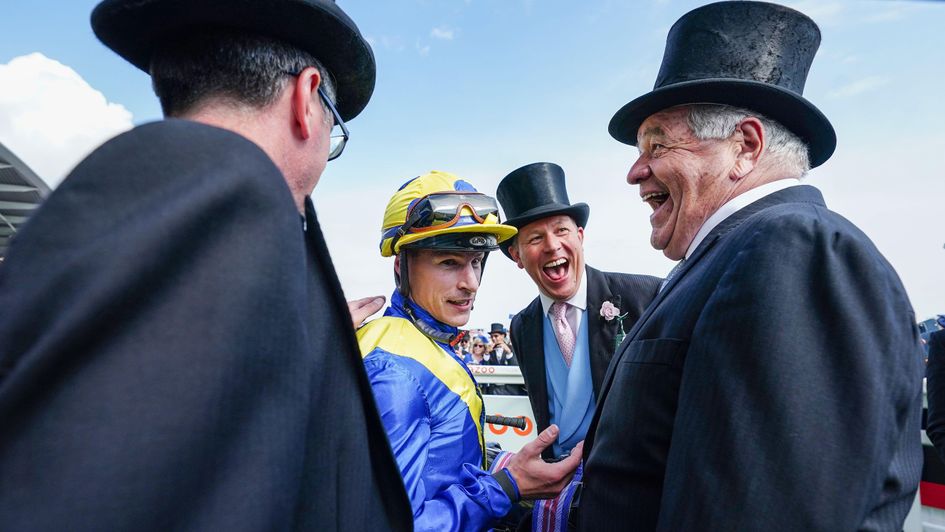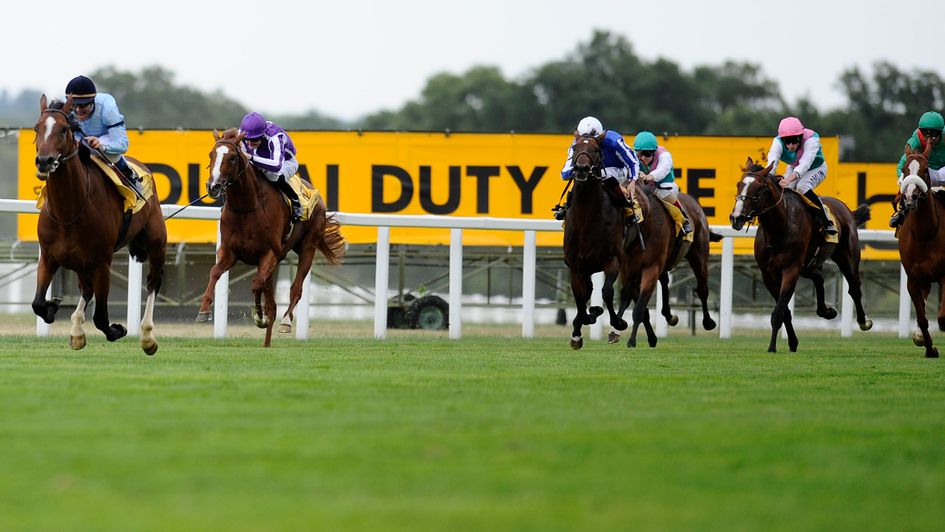John Ingles pays tribute to Sir Michael Stoute and his six decades of top-class winners around the world.
In his autobiography Calling The Horses, legendary commentator Sir Peter O’Sullevan recalls the audition process to recruit a new BBC Racing Correspondent which took place at Newbury racecourse in November 1965. With the BBC cameras in place to cover the following day’s Hennessy Gold Cup (won by Arkle), each of the six candidates was set the task of commentating on a race as part of the selection process. There were mixed fortunes for the sextet, but two of them stood out. It was to be the Daily Mirror’s Julian Wilson who would get the job which made him a long-time colleague of O’Sullevan’s at the BBC, but the twenty-year-old whom he narrowly beat to the post would go on to make a name for himself in racing in a very different capacity.
O’Sullevan described this candidate as ‘the horse-mad son of the Barbados chief of police’ who at the time was working at the Malton stable of Pat Rohan, having only been in the country for three months, and had never even been to a jumps meeting until his Newbury audition. Just over six years later, Michael Stoute received his trainer’s licence, embarking on a career which would bring him ten champion trainer titles and numerous victories in some of the world’s biggest races, along with a knighthood awarded in 1998 for ‘promotion of sport tourism’ in Barbados.
Recalling his early days in Britain – including the shock of a move from the Caribbean to the very different climate of North Yorkshire - in an interview in 2022, Stoute said: ‘I hadn’t been to Britain before going to Pat Rohan’s. Fortunately, it was August but that first winter was tough.’
Explaining that initial plans to work in Ireland had fallen through, Stoute continued, ‘I worked for Pat for three years and when I came to Newmarket I went to Doug Smith for two and a half years. I then went to Tom Jones where I had a year and a half. I rented Cadland Stables and I got fifteen horses and in those days you had to have twelve to get a licence and it started from there.’
Stoute’s first winner was Sandal, owned by his father and rated 99 by Timeform that season, who was ridden to victory by Lester Piggott in a handicap at Newmarket in April 1972. But it was a couple of winning two-year-olds in that first season, Alphadamus and Blue Cashmere, who were soon to be instrumental in getting Stoute’s career under way.
‘Alphadamus won the Stewards’ Cup in my second season. Blue Cashmere won the Northumberland Sprint Trophy and the Ayr Gold Cup and the Trafalgar House Handicap at Ascot the week after the Ayr Gold Cup. Those were the two who got me moving a bit. Thank God I hit the ground running as you can get buried quickly.’
But sprint handicappers weren’t to be the type of horses for which Stoute would become best known. In any case, Blue Cashmere proved much better than a handicapper at four, winning the Nunthorpe Stakes (not then a Group 1) and earning a Timeform rating of 129.
It wasn’t long before more good horses started being sent to Stoute who by then was operating from the first of his own yards in Newmarket, Beech Hurst Stables. In the same year, 1978, that he won the Gold Cup for the first time with Shangamuzo, who’d joined the stable that season as a five-year-old, Stoute had his first classic winner Fair Salinia, who added to her Oaks win at Epsom with success in the Irish Oaks (which she was awarded) and the Yorkshire Oaks which Stoute would go on to win a record-equalling nine times.
But while Fair Salinia was the first of Stoute’s sixteen English classic winners in his own name, he’d been closely involved with the 1969 Oaks winner Sleeping Partner and the 1971 St Leger winner Athens Wood as assistant trainer at the two Newmarket yards he had worked for previously.
Stoute’s other Oaks winner, Unite – also another of his six Irish Oaks winners - followed nine years later in Sheikh Mohammed’s colours. The trainer’s first 1000 Guineas winner, Musical Bliss in 1989, was in the same ownership, while his other one, Russian Rhythm in 2003, was among plenty of very good fillies Stoute trained for Cheveley Park Stud, including Peeress, Integral and Queen’s Trust who was one of Stoute’s three Breeders’ Cup Filly & Mare Turf winners.
Two more of Stoute’s best fillies, Sonic Lady (winner of the Irish 1000 Guineas) and Milligram, won successive editions of the Coronation Stakes and went on to success in open company, in the Sussex Stakes and Queen Elizabeth II Stakes respectively, with Milligram earning a 130 rating after beating top-class French filly Miesque and the year-older Sonic Lady in the first Group 1 running of the latter contest.
Among Stoute’s other Yorkshire Oaks winners were the Lord Weinstock-owned mother and daughter pair Hellenic and Islington, the latter winning the race twice and becoming another of her stable’s Breeders’ Cup Filly & Mare Turf winners, while Petrushka, who also won the Irish Oaks and Prix de l’Opera in addition to the Yorkshire Oaks, is another of the best middle-distance fillies Stoute trained.
Stoute earned royal patronage too, and the most notable winner he trained for Queen Elizabeth II was her 2013 Gold Cup winner Estimate. At the other end of the distance scale, the best sprinter Stoute trained of either sex was the top-class Marwell (133) who ended an unbeaten two-year-old season in the Cheveley Park Stakes and trained on to win the King’s Stand Stakes, July Cup and Prix de l’Abbaye at three.
Attracting the support of leading owners was the biggest boost to Stoute’s early career and none proved more significant than the Aga Khan who, in the year that Fair Salinia and Shangamuzo had done much to advertise their young trainer’s skill, selected Stoute, along with Fulke Johnson Houghton, when choosing to have horses trained in Britain again. ‘I wanted young men with good judgement who would prepare my horses with a stud career in the background. Therefore, it was imperative to choose those who do not overrate their charges’, the Aga Khan told Richard Baerlein in his book Shergar.
Stoute’s brilliant 1981 Derby winner was among just the second batch of yearlings he received from the Aga Khan. Shergar followed his record-breaking ten-length victory at Epsom with wins in the Irish Derby and King George VI & Queen Elizabeth Stakes, earning an outstanding Timeform rating of 140 and helping Stoute become champion trainer for the first time in the same season that Marwell developed into a top-class sprinter.
Shergar was only the fourth horse Stoute had run in the Derby but he was also the first ride in the race for his nineteen-year-old jockey Walter Swinburn who had initially joined Stoute as understudy to Lester Piggott, though was soon promoted to stable jockey in 1981 after Piggott’s move to Henry Cecil.
Stoute, Swinburn and the Aga Khan combined to win a second Derby (and Irish Derby) with Shahrastani five years later, while in the current century Stoute took his total of Derby victories to six thanks to Kris Kin, North Light, Workforce and Desert Crown. The pick of those was Workforce who broke the Epsom course record in 2010, for another of Stoute’s greatest supporters Khalid Abdullah, with Workforce going on to become Stoute’s only winner of the Prix de l’Arc de Triomphe. Stoute’s final Derby winner Desert Crown in 2022, for Kris Kin’s owner Saeed Suhail, was a fine feat of training with a fragile colt who raced only four times in total (replay below). Two of those Derby winners, Kris Kin and North Light, were partnered by Kieren Fallon, who’d briefly been stable jockey, but much the most successful jockey for Stoute in the latter part of his career was Workforce’s rider Ryan Moore.

Unlimited Replays
of all UK and Irish races with our Race Replays
Discover Sporting Life Plus Benefits

Another in Suhail’s blue and yellow colours was Workforce’s sire King’s Best, one of five winners of the 2000 Guineas that Stoute trained, along with Shadeed, the Aga Khan’s Doyoun, Entrepreneur and Golan, with the last-named having won a Chepstow maiden eight months earlier on his only previous start. Golan was another who carried the Weinstock colours, later those of Ballymacoll Stud for whom Stoute trained one of those Derby winners, North Light, and his only St Leger winner Conduit, also a dual Breeders’ Cup Turf winner.
Two more top-class three-year-old colts, both owned by Maktoum Al Maktoum, were his 1983 Irish Derby winner Shareef Dancer and Timeform’s 1989 Horse of The Year Zilzal (rated 137), unbeaten in five starts, including the Sussex Stakes and Queen Elizabeth II Stakes, until his only defeat at the Breeders’ Cup.
But for all the classic winners and many top-class three-year-olds which Stoute trained, it will be his success with older horses that he’s doubtless best remembered. He was certainly the first trainer we’d turn to when it came to selecting older horses for Timeform’s Horses To Follow books, invariably those who’d been brought along patiently at three. The trainer’s most recent Group 1 winner, Bay Bridge, successful in the 2022 Champion Stakes, and this season’s Huxley Stakes winner Passenger, Stoute’s sole pattern winner to date in 2024, were two such horses.
All six of Stoute’s Eclipse winners were four- or five-year-olds and so too were his six winners of the Juddmonte International – Ezzoud, Notnowcato and Ulysses won both races – while Shergar turned out to be his only three-year-old winner of the King George. Stoute’s six winners of the Ascot race is a record, two of them, Golan (successful on his season reappearance again) and Conduit having already been mentioned. Conduit beat stablemates Tartan Bearer and Ask in a one-two-three for the yard when successful in 2009 which was also the year of the last of Stoute’s ten trainers’ championships.
Stoute’s other King George winners included Sheikh Mohammed’s five-year-old Opera House (whose dam Colorspin was another of Stoute’s Irish Oaks winners), also winner of the Coronation Cup and Eclipse that season and beaten less than a length into third in the Arc. His highest-rated King George winner, though, was Harbinger, successful in 2010. In a light three-year-old campaign, Harbinger won the Gordon Stakes and finished third in the St Leger but made huge strides at four, winning the John Porter, Ormonde and Hardwicke before an astonishing performance in the King George. Three-year-old stablemate Workforce was sent off odds-on to follow up his Derby victory but it was all about Harbinger who drew clear to win by the record margin of eleven lengths. It earned Harbinger a Timeform rating equal to that of Shergar’s, though unfortunately injury denied him an opportunity to back up his Ascot effort.
For success as older horses, much of it overseas, the top-class contemporaries Singspiel (133) and Pilsudski (134) rank among Stoute’s most notable performers, winning 19 races and well over six million pounds between them in the late 1990s. Sheikh Mohammed’s Singspiel won the Canadian International and Japan Cup in 1996 in the autumn of his four-year-old season and added domestic Group 1 wins in the Coronation Cup and Juddmonte International at five after a successful switch to dirt to land just the second running of the Dubai World Cup.
Graduating from handicaps at three, Pilsudski was beaten by Singspiel when both made their four-year-old reappearances in the Gordon Richards Stakes at Sandown but turned the tables on his stablemate at the end of the year when they finished one-two in the Breeders’ Cup Turf at Woodbine, giving Stoute the first of his eight victories at the Breeders’ Cup. Better still at five, Pilsudski, described by his trainer as ‘one of the best-looking horses you’ll see…with an iron constitution’, succeeded Singspiel on the Japan Cup’s roll of honour at the end of a season which had brought him wins in the Eclipse, Irish Champion Stakes and Champion Stakes and second places in the King George and Arc.
The Aga Khan’s Kalanisi (rated 132, and by one of Stoute’s 2000 Guineas winners Doyoun) was another top-class winner of both the Champion Stakes and Breeders’ Cup Turf, in 2000, who’ll also be remembered for his close battles with Giant’s Causeway in the Eclipse and Juddmonte International.
As victories in the Dubai World Cup and Japan Cup show, Stoute was prepared to try something a bit different on occasions and that was certainly the case with Sheikh Mohammed’s grey gelding Kribensis. Switched to hurdles, he won the Triumph Hurdle and then the Champion Hurdle two years later, along with a Fighting Fifth and two Christmas Hurdles in between. After his retirement from racing, Kribensis remained at Freemason Lodge as the stable hack until his death at the age of 23.
In the same ownership, 1986 Dewhurst Stakes winner Ajdal – a rare two-year-old Group 1 winner - was another who had an unorthodox campaign, finishing in mid-division in the Derby but then earning the title of best sprinter from Timeform when Stoute dropped him back markedly in trip to win the July Cup, William Hill Sprint Championship (Nunthorpe) and the Sprint Cup.
The cricket-loving Stoute will retire at the end of the year after an innings which has amassed well over 4000 winners in Britain, a total surpassed only by Mark Johnston, Martin Pipe and Richard Hannon senior. Until Aidan O’Brien overtook him last year, Stoute’s 82 winners at Royal Ascot was a record.
Having announced his forthcoming retirement, Stoute will no doubt be much in demand in any remaining racecourse appearances he makes for the rest of the year. But how successful his would-be interviewers are in getting him in front of the camera is another matter given that Stoute isn’t known for relishing such media attention. That, of course, is rather at odds with his ambitions early in life which could have seen him on the other side of the microphone as the face of the BBC’s coverage of racing. Given the phenomenal success he enjoyed as a trainer instead, that November day at Newbury almost 60 years ago was therefore probably the one time in Stoute’s career when finishing second was the best possible result.
More from Sporting Life
Safer gambling
We are committed in our support of safer gambling. Recommended bets are advised to over-18s and we strongly encourage readers to wager only what they can afford to lose.
If you are concerned about your gambling, please call the National Gambling Helpline / GamCare on 0808 8020 133.
Further support and information can be found at begambleaware.org and gamblingtherapy.org.







